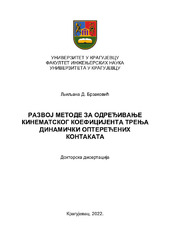Приказ основних података о дисертацији
Razvoj metode za određivanje kinematskog koeficijenta trenja dinamički opterećenih kontakata
Development of the method for determination of kinematic coefficient of friction of dynamically loaded contacts
| dc.contributor.advisor | Mitrović, Slobodan | |
| dc.contributor.other | Vukelić, Đorđe | |
| dc.contributor.other | Tadić, Branko | |
| dc.contributor.other | Milovanović, Vladimir | |
| dc.creator | Brzaković, Ljiljana D. | |
| dc.date.accessioned | 2023-09-06T12:18:15Z | |
| dc.date.available | 2023-09-06T12:18:15Z | |
| dc.date.issued | 2022 | |
| dc.identifier.uri | http://eteze.kg.ac.rs/application/showtheses?thesesId=8676 | |
| dc.identifier.uri | https://fedorakg.kg.ac.rs/fedora/get/o:1635/bdef:Content/download | |
| dc.identifier.uri | https://nardus.mpn.gov.rs/handle/123456789/21636 | |
| dc.description.abstract | Kinematski koeficijent trenja se, generalno posmatrano, u svim uslovima opterećenja kontakta, može odrediti potpuno drugačijim metodama u odnosu na postojeće metode koje se zasnivaju na merenju nivoa opterećenja kontakta i merenju sile trenja. Metoda koja se predlaže odnosi se na određivanje kinematskog koeficijenta trenja preko dinamičke jednačine kretanja pri obrtanju tela, pri čemu aktivna sila na obrtno telo deluje samo u trenutku iniciranja kretanja, dok statičku i dinamičku komponentu željenog opterećenja kontakta tipa "rukavac-ležaj" obezbeđuju mase tela, koncentrično i ekscentrično raspoređene u odnosu na osu obrtanja. Ako se eksperimentalnim putem odredi zavisnost promene ugla obrtanja tela u funkciji vremena, onda je na osnovu dinamičke jednačine kretanja moguće odrediti trenutne vrednosti koeficijenta trenja u čitavom periodu vremena, od iniciranja kretanja do trenutka prestanka obrtanja tela. U disertaciji su izloženi rezultati teorijskih i eksperimentalnih analiza vezanih za kinematski koeficijent trenja kotrljajnog ležaja u uslovima manuelnog (ručnog) iniciranja obrtnog kretanja i pri iniciranju kretanja dinamičkom udarnom silom. Nakon iniciranja kretanja i prestanka dejstva spoljašnje sile (udarnog impulsa) kretanje se nastavlja, pri čemu opterećeni ležaj (zona ležaja u kojoj dejstvuju sile otpora trenja) prolazi čitav spektar brzina, od maksimalne brzine u trenutku iniciranja kretanja, do njene nulte vrednosti pri zaustavljanju kretanja, pri čemu se čitav merni sistem svodi na rotacioni enkoder. Rezultati istraživanja prikazani u disertaciji kompatibilni su sa rezultatima dobijenim primenom konvencionalnih tribodijagnostičkih metoda i ukazuju na fizičku vezu koeficijenta trenja i ugaonog ubrzanja. Tako se može reći da je ubrzanje fizički i energetski pokazatelj trenja i rasipanja energije u tribomehaničkim sistemima i da definiše kompletnu dinamiku samog procesa trenja. | sr |
| dc.description.abstract | The kinematic coefficient of friction, generally speaking, in all contact load conditions, can be determined by completely different methods compared to existing methods that are based on measuring the contact load level and measuring the friction force. The proposed method refers to the determination of the kinematic coefficient of friction through the dynamic equation of motion when the body rotates, whereby the active force on the rotating body acts only at the moment of motion initiation, while the static and dynamic component of the desired load of the "sleeve-bearing" type contact is provided by the masses of the body, concentrically and eccentrically arranged in relation to the axis of rotation. If the dependence of the change in the angle of rotation of the body as a function of time is determined experimentally, then based on the dynamic equation of motion, it is possible to determine the current values of the coefficient of friction in the entire period of time, from the initiation of movement to the moment when the body's rotation stops. The dissertation presents the results of theoretical and experimental analyzes related to the kinematic coefficient of friction of the rolling bearing under the conditions of manual (manual) initiation of rotary motion and initiation of motion by dynamic impact force. After the movement is initiated and the effect of the external force (impact impulse) ceases, the movement continues, whereby the loaded bearing (bearing zone where the frictional resistance forces act) passes through the entire range of speeds, from the maximum speed at the moment of movement initiation, to its zero value when the movement stops, whereby the entire measuring system is reduced to a rotary encoder. The research results presented in the dissertation are compatible with the results obtained using conventional tribodiagnostic methods and indicate a physical connection between the coefficient of friction and angular acceleration. So it can be said that acceleration is a physical and energetic indicator of friction and energy dissipation in tribomechanical systems and defines the complete dynamics of the friction process itself. | en |
| dc.format | application/pdf | |
| dc.language | sr | |
| dc.publisher | Универзитет у Крагујевцу, Факултет инжењерских наука | sr |
| dc.rights | openAccess | en |
| dc.rights.uri | https://creativecommons.org/licenses/by-nd/4.0/ | |
| dc.source | Универзитет у Крагујевцу | sr |
| dc.subject | trenje | sr |
| dc.subject | friction | en |
| dc.subject | friction coefficient | en |
| dc.subject | initiation of motion | en |
| dc.subject | angle | en |
| dc.subject | angular acceleration | en |
| dc.subject | angular velocity | en |
| dc.subject | differential equation of motion | en |
| dc.subject | energy balancе | en |
| dc.subject | koeficijent trenja | sr |
| dc.subject | iniciranje kretanja | sr |
| dc.subject | ugao | sr |
| dc.subject | ugaono ubrzanje | sr |
| dc.subject | ugaona brzina | sr |
| dc.subject | diferencijalna jednačina kretanja | sr |
| dc.subject | bilans energija | sr |
| dc.title | Razvoj metode za određivanje kinematskog koeficijenta trenja dinamički opterećenih kontakata | sr |
| dc.title.alternative | Development of the method for determination of kinematic coefficient of friction of dynamically loaded contacts | en |
| dc.type | doctoralThesis | |
| dc.rights.license | BY-ND | |
| dc.identifier.fulltext | http://nardus.mpn.gov.rs/bitstream/id/151897/Disertacija.pdf | |
| dc.identifier.rcub | https://hdl.handle.net/21.15107/rcub_nardus_21636 |


